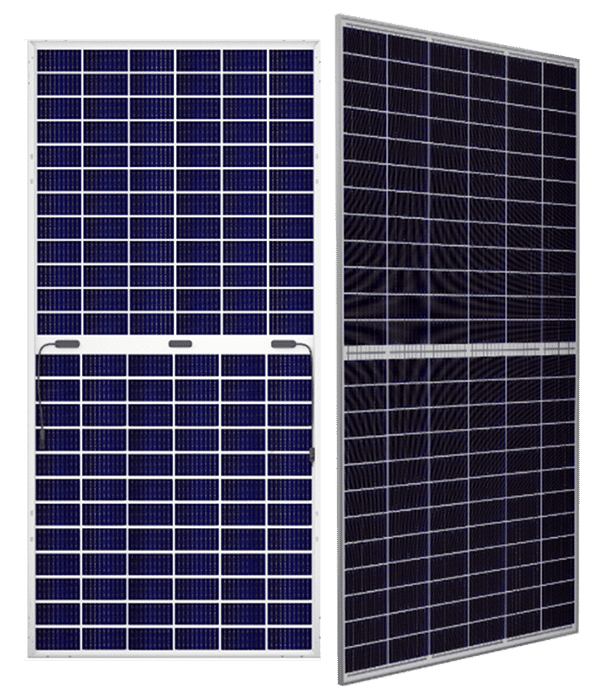Bifacial solar panels are a relatively new technology that has increased in popularity over the past few years. These double-sided panels trade increased efficiency for a slightly more difficult installation process.
What are Bifacial Solar Panels?
Standard non-bifacial solar panels are primarily composed of three layers. On top, a layer of transparent glass protects the solar panels and allows the sunlight to pass through. Below that, a layer of silicon converts this solar energy into power. Below the silicon sits an aluminum frame that gives the panel strength and rigidity. Bifacial panels differ from these standard panels in one important way. Instead of a bottom frame consisting of aluminum, there is another layer of glass that allows for the reabsorption of reflected light from the ground.
You can think of bifacial panels almost like an ice cream sandwich. The cookies on top and bottom are the glass, and the ice cream in the center is the silicon that transforms incoming solar power into electrical power.
There are several ways that these bifacial solar panels can be set up. Typically, they are arranged so that one side faces the sun and the other gathers reflected light from the ground.
How to Maximize the Advantages of Bifacial Solar Panels
Bifacial solar panels are similar in shape to standard solar panels; they’re flat. This means that only one side is able to gather energy directly from the sun at any given time.
If you set up your solar panels at an angle over reflective surfaces, you can see up to 10% extra solar power generation. The light reflected off the ground determines the amount of extra power that two-sided panels generate. One way we can measure the amount of reflected light is by looking into the albedo of various substances.
What is Albedo?
Scientists use the term albedo to rate how much light is reflected off of a given surface. If you’ve ever been skiing, you know that fresh snow reflects light very effectively. Snow has an albedo of .9, meaning, up to 90% of all incoming sunlight is reflected. On the other hand, fresh black asphalt has an albedo of around .05.
Therefore, when installing bifacial solar panels, check the ground underneath them. Installing bifacial solar panels over asphalt will result in almost no added efficiency, while installation over bright high-albedo surfaces, like white sand, will result in higher efficiency.
Rule of thumb: brightly colored or white substances typically have a higher albedo.
Tips for Installation of Bifacial Solar Panels
If you have limited space for your panels and a high need for energy, you should go with bifacial solar panels. Here are some tips for the installation.
Most of the damage done to a solar panel over the course of its lifespan occurs during installation and maintenance. At SanTan Solar, we firmly believe in the old adage: “Measure Twice, Cut Once.” Before you climb up on the roof of your house, make a detailed plan for where you’ll be placing your frame, where you’ll be running your wires, and what you’ll be using as a highly reflective material to maximize reflected light.
A part of this planning step involves deciding how you’ll be incorporating high-albedo materials below your solar panels. What should you use for your reflective material?
Reflective Materials
While snow and white sand both excel in their reflective properties, neither would last long on a roof during normal weather conditions. We recommend two main solutions. The first is painting the material beneath your panels with white paint. This could mean your roof tiles, painting asphalt, or whatever other material that may sit beneath your panels.
The other solution is white rocks. You can find cheap bags of high-albedo rocks at Lowe’s or online. Remember, anything white typically has a higher albedo than darker colored objects. The lighter you can get the ground under your panels, the better they’ll perform.
Angle of Installation
Even if the materials under your panels are highly reflective, you must install them at an angle or no light will reflect off the ground. Angling the panels will ensure both sides gather the light.
Conclusion
Bifacial solar panels are an exciting new technology and although you might need to get creative with the installation, bifacial panels are highly efficient and can generate up to 30% more energy production in ideal conditions.
Remember: install your new bifacial panels at an angle and over highly reflective surfaces to maximize the benefits!

